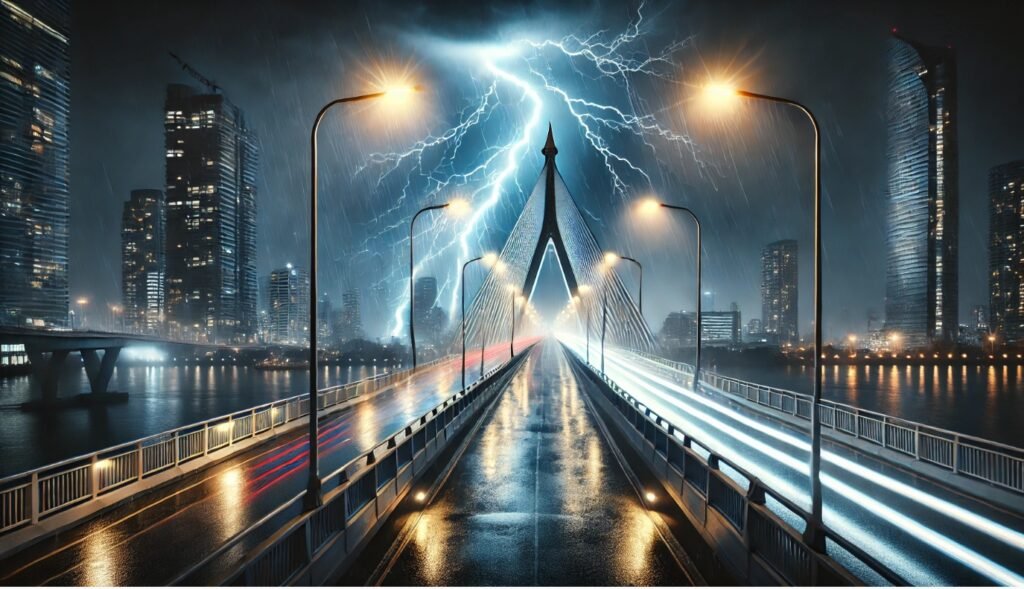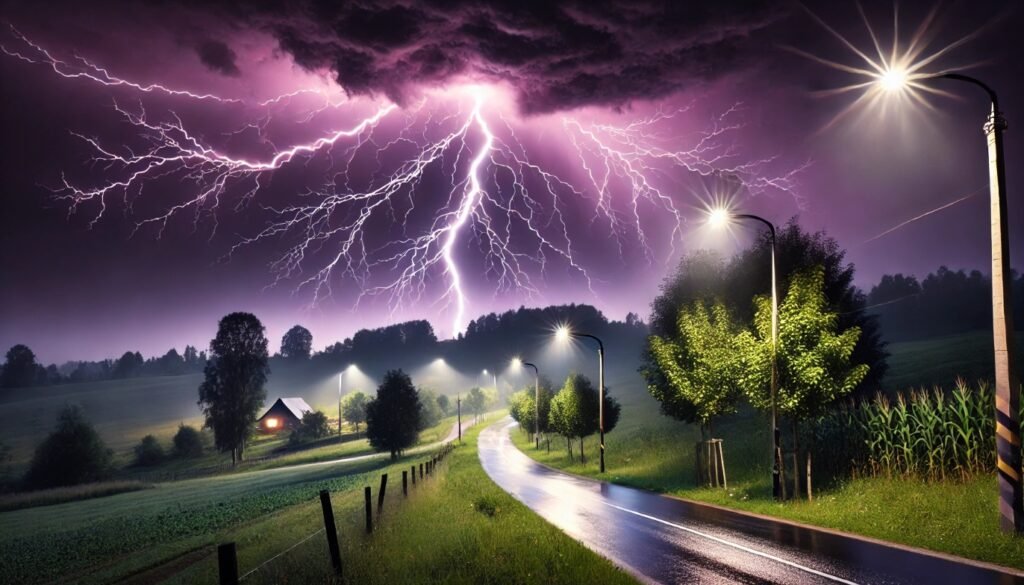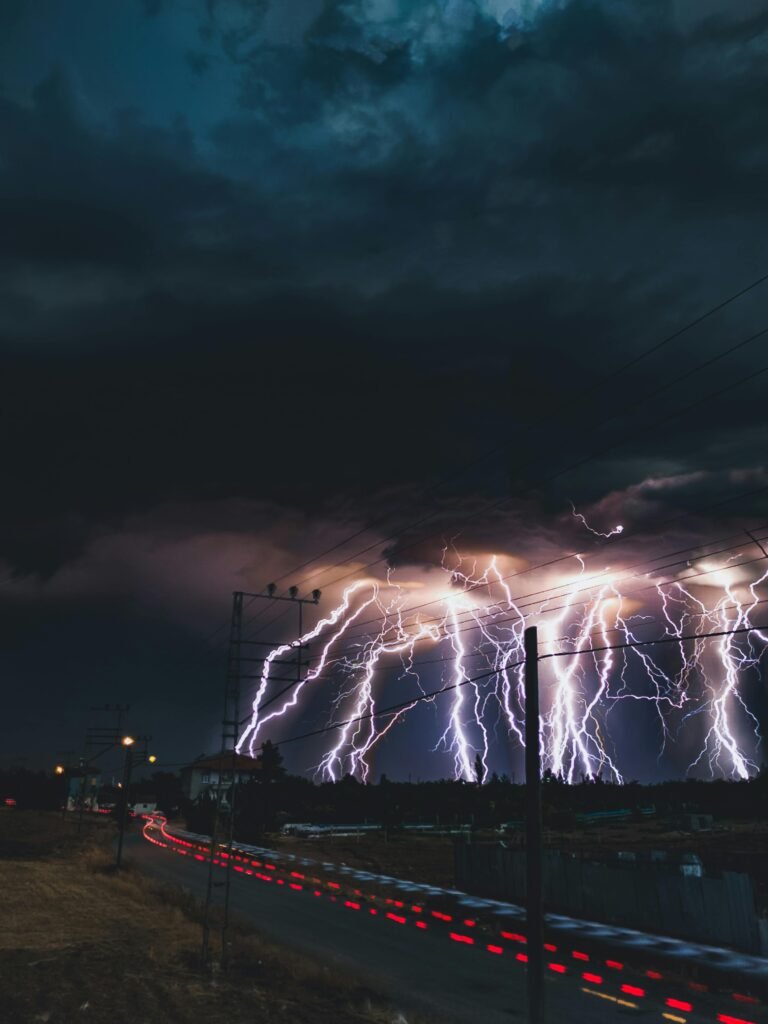How to Protect LED Streetlights from Lightning Strikes?
1. Introduction
1.1 Importance of Lightning Protection for LED Streetlights
LED streetlights are essential for modern urban infrastructure, providing energy efficiency, long lifespan, and reduced maintenance costs. However, their sensitivity to electrical surges and lightning strikes makes lightning protection crucial.
Without proper protection, lightning can cause:
- Burnout of LED drivers and power supply units.
- Damage to control systems and sensors.
- Sudden power outages and increased maintenance costs.
Implementing a multi-layered lightning protection system ensures the reliability and longevity of LED streetlighting networks.
1.2 Can LED Lights Be Affected by Lightning?
Yes, LED streetlights are highly susceptible to lightning-induced surges due to:
- Direct strikes, which can physically destroy the lamp and pole.
- Indirect surges, where lightning hits nearby power lines, generating transient overvoltages.
- Electromagnetic induction, where nearby lightning alters the voltage in connected circuits.
Real-world examples show up to 70% of LED streetlight failures in some regions are due to lightning-related power surges.

2. Understanding Lightning Strikes and Electrical Surges
2.1 What is a Surge Voltage?
A surge is a transient increase in voltage, current, or power within an electrical circuit.
Common sources of surges:
- Lightning strikes (most dangerous, causing thousands of volts in microseconds).
- Power grid switching (high-power equipment turning on/off).
- Electromagnetic induction from nearby lightning.
Even brief voltage spikes (lasting microseconds to milliseconds) can cause catastrophic damage to LED drivers and power circuits.
2.2 Different Kinds of Surges and Their Damage
| Type of Surge | Cause | Impact on LED Streetlights |
|---|---|---|
| Lightning-Induced Surges | Direct or indirect lightning strikes | Burnout of LED drivers, destruction of circuit boards |
| Power Grid Switching Surges | Large equipment turning on/off | Gradual degradation of LED drivers and power modules |
| Induced Surges | Nearby lightning generating electromagnetic fields | Random failures of LED luminaires, signal disruptions |
2.3 What is the Difference Between Common Mode and Differential Mode Surge?
- Common mode surge: Between power line and ground (e.g., line-to-earth, neutral-to-earth).
- Differential mode surge: Between two active lines (e.g., line-to-line, line-to-neutral).
Why does this matter?
- LED drivers are more sensitive to differential mode surges, requiring special protection circuits.

3. Key Protection Strategies for LED Streetlights
3.1 How Do You Protect LED Lights from Lightning?
A multi-layered defense strategy combining grounding, shielding, and surge protection devices (SPDs) is essential.
3.2 Proper Grounding and Earthing Systems
- Objective: Safely dissipate lightning energy into the ground.
- Recommended resistance level: ≤10 ohms.
- Best Practices:
- Use copper-clad steel grounding rods.
- Ensure low-resistance connections between pole and ground system.
3.3 Setting Up Lightning Protection Zones (LPZs)
LPZs create controlled environments where sensitive electronics (e.g., smart controllers) are isolated from high-voltage surges.
Example: Installing lighting controllers inside an LPZ shielded enclosure to reduce electromagnetic exposure.
3.4 Using Equipotential Bonding to Minimize Voltage Differences
- Objective: Eliminate dangerous voltage differences.
- Implementation: Connect power lines, control circuits, and metal poles to a single grounding system.
3.5 External vs. Internal Lightning Protection Systems
| Protection Type | Function | Components |
|---|---|---|
| External Lightning Protection | Prevents direct strikes from damaging structures | Lightning rods, grounding networks |
| Internal Lightning Protection | Protects electrical components from surges | Surge protectors, shielding, voltage limiters |
Key Takeaway: Both systems must be used together for optimal protection.
3.6 Do LED Lights Need a Surge Protector?
✔ YES. LED drivers are highly sensitive to high transient voltages.
✔ SPD selection criteria:
- Type 1 SPD – For high-exposure locations (e.g., highways, bridges).
- Type 2 SPD – Installed within LED luminaires for secondary protection.
- Type 3 SPD – For highly sensitive components, such as control circuits.

4. Surge Protection Devices (SPD) and Compliance Standards
4.1 How Do Surge Protection Devices Work?
- SPDs absorb excess energy and redirect it to the ground, preventing voltage spikes from reaching sensitive components.
4.2 International Standards for SPD Testing and Certification
| Standard | Region | Application |
|---|---|---|
| IEC 61643-12 | International | General SPD requirements |
| UL 1449 | USA | SPD safety certification |
| EN 61643-12 | Europe | Performance and installation guidelines |
4.3 Choosing the Right SPD for LED Streetlights
- Voltage Rating: Match SPD protection level to grid voltage (230V, 400V, etc.).
- Protection Class:
- Class I (Direct lightning exposure).
- Class II (Typical urban installations).
- Class III (Indoor/sensitive electronics).
5. Practical Applications and Real-World Solutions
5.1 What is the Best Protection Against Lightning Strikes?
✔ Best approach = Combination of SPD, grounding, and shielding.
✔ Case studies show up to 90% reduction in LED failures with this method.
5.2 Case Studies of Effective Lightning Protection for LED Streetlights
- Smart city project: 30,000 LED streetlights upgraded with SPDs, reducing failures by 85%.
- High-altitude highway: Specialized grounding and SPD system prevented 90% of lightning damage.
5.3 Installation and Maintenance Best Practices
- SPD lifespan: Replace after each major lightning event.
- Grounding inspection: Check resistance levels every 6 months.
- Visual inspection: Look for burn marks or damaged SPD components.
6. Conclusion
6.1 Summary of Best Practices
✔ Multi-layered protection approach = Best strategy.
✔ Regular SPD and grounding maintenance prevents failures.
✔ Compliance with IEC 61643-12 ensures international safety standards.
6.2 Final Recommendations for LED Streetlight Protection
- Cities should invest in certified SPDs for long-term savings.
- Routine inspections and proper installation are key to protection.
- Future innovations (e.g., smart SPD monitoring) will enhance lightning protection further.

